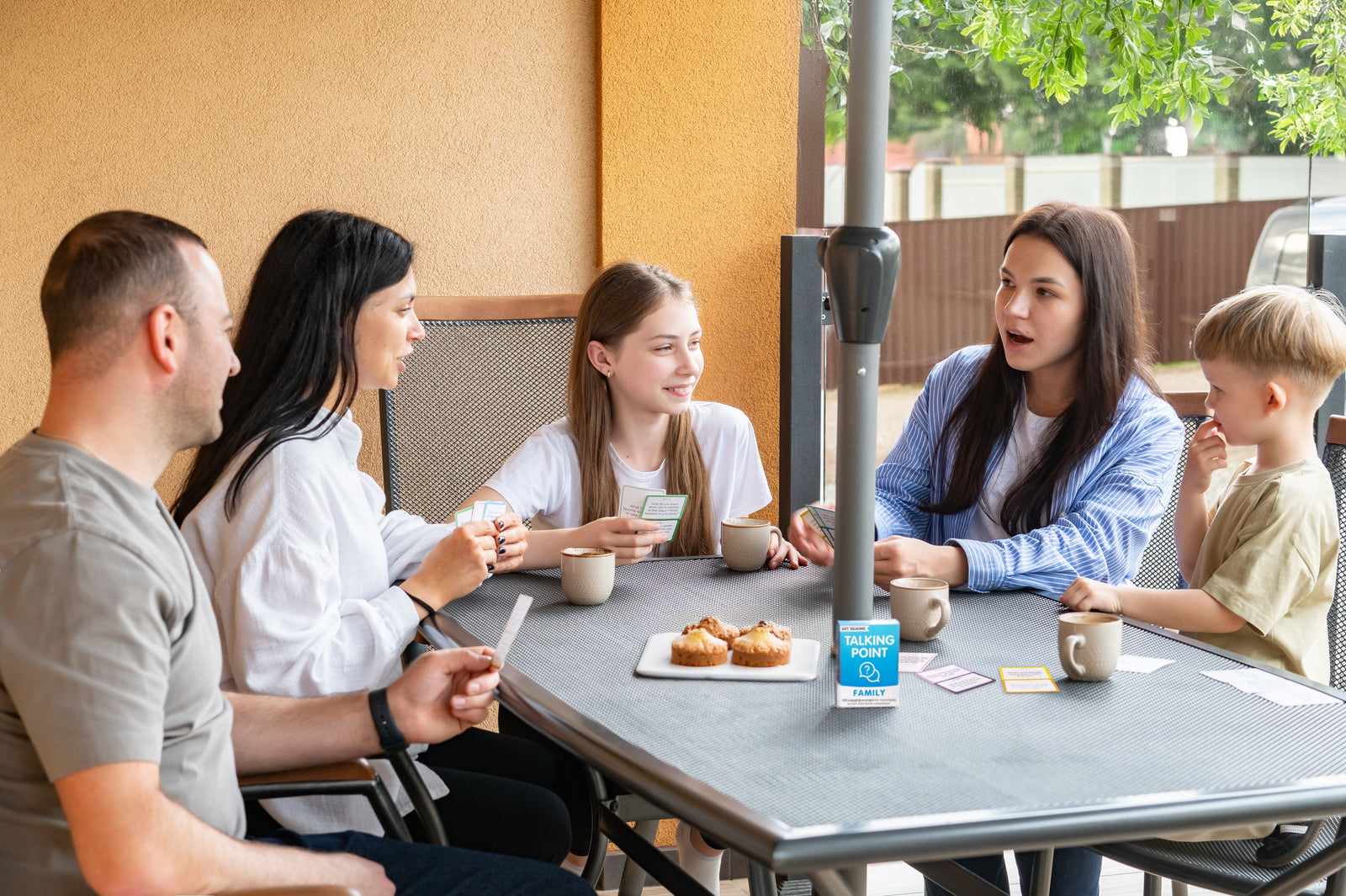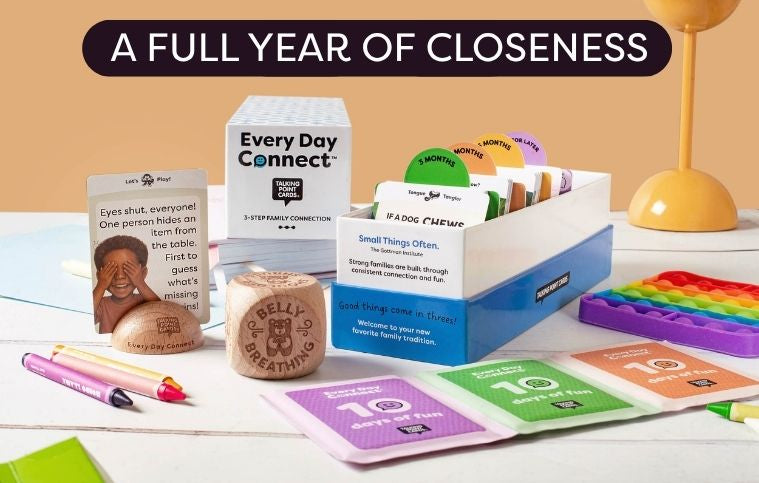SHOP
About

Top 10 Fun Card Games for Kids of All Ages
February 28, 2025 10 min read
Fun Family Card Games
Finding ways to unite the family in our digitally dominated world can be challenging.
Kids, especially, can be easily distracted by the various digital devices at our disposal.
However, the solution can be much simpler than you think.
Card games have brought families and friends together to enjoy quality time for centuries, and there’s no shortage of them in our modern era.
These games can range from entertaining, educational, strategic, and everything. It’s an easy way to cut out a chunk of time where you can get the whole family involved.
Whether you’re looking to make a new family tradition or engage your kids in a fun activity, fun card games provide the perfect opportunity for kids to disconnect from digital devices and reconnect with each other.
If you’re already a fan of traditional card games but tired of using the same old classic cards you found deep in a drawer, you might want to check out our collection of custom-playing cards!
With various styles to choose from, you’ll be able to find a deck that fits your interests and catches the eyes of any guests you have over.
They’re not just all looks either; made from 310gsm German-made black-core paper, these cards are casino-grade, offering incredible durability for smoother shuffling, dealing, and general play.
Explore Our Custom Playing Cards Collection
Old Maid
Old Maid is a simple and fun card game for kids that involves two or more players. The goal is to avoid being left with the “Old Maid” (usually a single unmatched card) at the end of the game.
Setup:
-
Use a standard 52-card deck, but remove one Queen (or any other single card) to create an odd number of cards.
-
Alternatively, you can use a special Old Maid deck, which includes a unique “Old Maid” card instead of removing a Queen.
-
Shuffle and deal all the cards evenly to the players. Some players may have one more card than others, which is fine.
How to Play:
-
Form Pairs – Players look at their hands and place any matching pairs face down. A pair consists of two cards of the same rank (e.g., two Jacks or two Fours).
-
Taking Turns – The first player (often the youngest) offers their remaining cards, face-down, to the player on their left. That player picks a random card from the offering hand.
-
Pairing Up – If the chosen card forms a new pair with one in the player’s hand, they set it aside.
-
Passing Cards – The player who just took a card now offers their remaining cards to the next player, and so on.
-
The Old Maid – Since one card (usually a Queen) has no match, one player will eventually be left holding it.
Winning the Game:
-
The game continues until all pairs have been made.
-
The player left holding the unpaired “Old Maid” loses, while all other players win.
Go Fish
Go Fish is a classic and easy-to-learn card game for kids and families. The goal is to collect the most sets of four matching cards.
Setup:
-
Use a standard 52-card deck.
-
2-6 players can play.
-
Dealing:
-
2-3 players: Deal seven cards to each.
-
4+ players: Deal five cards to each.
-
Place the remaining deck face-down in the center as the “fishing pond.”
How to Play:
-
Starting the Game: The player to the dealer’s left goes first.
-
Asking for a Card:
-
On their turn, a player asks another player for a specific rank (e.g., “Do you have any Sevens?”).
-
You must already have at least one card of that rank to ask for it.
-
Giving or “Going Fish”:
-
If the asked player has the requested rank, they must give the asker all copies of that rank.
-
If they don’t have the card requested, they say, “Go Fish!” The asker draws one card from the deck.
-
Making a Book (Set of 4):
-
When players collect all four cards of a rank (e.g., all four Jacks), they place them face-up in front of them.
-
Next Turn:
-
If the asker gets the card they asked for, they go again.
-
If they “Go Fish” and draw the requested card, they show it and take another turn.
-
Otherwise, the turn moves to the next player.
Winning the Game:
-
The game ends when all cards are part of books (sets of four).
-
The player with the most books wins!
Crazy Eights
Crazy Eights is a fun and fast-paced card game perfect for kids of all ages. The goal is to be the first player to eliminate all your cards.
Setup:
-
Use a standard 52-card deck.
-
2-5 players: Each player is dealt five cards.
-
6+ players: Each player is dealt seven cards.
-
Place the remaining deck face-down as the draw pile.
-
Flip the top card to start the discard pile. If it’s an 8, shuffle it back into the deck and flip a new card.
How to Play:
-
Starting the Game:
-
The player to the left of the dealer goes first.
-
Playing a Card:
-
On your turn, you must play a card that matches the top card on the discard pile by rank (number/face) or suit.
-
Example: If the top card is a 5 of Hearts, you can play any five or any Heart.
-
Eights are wild! You can play an eight at any time and choose any suit for the next player to follow.
-
Drawing a Card:
-
If you can’t play, draw one card from the deck.
-
If that card is playable, you can play it immediately. Otherwise, your turn ends.
-
Winning the Game:
-
The first player to get rid of all their cards wins!
-
If the draw pile runs out, shuffle the discard pile (except the top card) to create a new draw pile.
Scoring (Optional for Multiple Rounds):
-
If playing multiple rounds, the winner gets 0 points, and the other players score based on the cards left in their hands:
-
8s = 50 points
-
Face cards = 10 points
-
Number cards = Face value
-
The player with the lowest score after several rounds wins
Snap
Snap is a fast-paced and straightforward card game for kids and adults that tests players’ reflexes. It’s great for kids and can be played with two or more players.
Setup:
-
Use a standard 52-card deck (or more for larger groups).
-
Shuffle the deck and deal all the cards evenly among the players.
-
Players keep their cards face-down in a personal stack—no peeking!
How to Play:
-
Taking Turns:
-
Players flip one card from their stack face-up onto a central pile.
-
The next player does the same, and the play continues clockwise.
-
Calling “Snap!”:
-
If two consecutive cards match (e.g., two Kings in a row), the first player to shout “Snap!” wins the pile.
-
The winner takes the pile and adds it to the bottom of their stack.
-
Snap Pot (Tie Rule):
-
If two players call “Snap!” simultaneously, the matching pile is placed in the middle as the Snap Pot.
-
Play continues until another matching pair appears. The first player to call “Snap!” gets the Snap Pot and the usual pile.
-
Running Out of Cards:
-
If players run out of cards, they are out of the game.
-
The last player with cards wins the game!
Concentration
Memory (Concentration, Pairs, or Match Match) is a simple and fun card game for kids that tests your ability to remember card locations. It’s great for kids and can be played solo or with multiple players.
Setup:
-
Use a standard 52-card deck (or a unique Memory game deck).
-
Remove Jokers and use only matching pairs (e.g., two Kings, two Fives, etc.).
-
Shuffle the cards and lay them face-down in a grid pattern (e.g., 4x4, 6x6, or larger for more difficulty).
How to Play:
-
First Player’s Turn:
-
Flip over two cards.
-
If they match (e.g., two Queens), keep them and take another turn.
-
If they don’t match, flip them face-down, and the turn passes to the next player.
-
Next Player’s Turn:
-
They flip two cards, trying to remember past card positions to find matches.
-
Winning the Game:
-
The game continues until all pairs have been found.
-
The player with the most matched pairs wins!
Slapjack
Slap Jack is a fun and fast-paced card game that tests your reflexes. The goal is to win all the cards by being the first to slap the Jacks when they appear.
Setup:
-
Use a standard 52-card deck.
-
Shuffle and deal all the cards face-down evenly among players (some may have one more card, which is fine).
-
Players do not look at their cards; they keep them in a face-down stack.
How to Play:
-
Taking Turns:
-
Players take turns flipping the top card from their stack and placing it face-up in the center.
-
The play moves clockwise.
-
Slapping the Jack:
-
If a Jack is played, all players try to slap the pile as fast as possible.
-
The first player to slap the Jack wins the entire pile and adds it to the bottom of their stack.
-
Running Out of Cards:
-
If players run out of cards, they get one last chance to slap a Jack and return to the game.
-
If they fail to do so, they are eliminated.
-
Winning the Game:
-
The game continues until one player has all the cards—they are the winner!
War
War is a simple two-player card game that relies entirely on luck. The goal is to win all the cards by having the highest-ranking card in each battle.
Setup:
-
Use a standard 52-card deck (no Jokers).
-
Shuffle and deal all the cards evenly (26 to each player).
-
Players do not look at their cards; they keep them in a face-down stack.
How to Play:
-
Battle:
-
Both players flip their top card and place it face-up in the center.
-
The player with the higher card wins both cards and places them at the bottom of their stack.
-
If the cards are equal, a War happens!
-
War (Tiebreaker):
-
Each player places three more face-down cards and one face-up card (some versions use only one).
-
The player with the higher face-up card wins all the cards in the pile.
-
If the face-up cards tie again, repeat the War!
-
Winning the Game:
-
The game continues until one player has all the cards and wins.
-
If players run out of cards during a War, they lose immediately.
Spoons
Spoons is a fast-paced card game that combines matching and quick reflexes. The goal is to collect four of a kind and grab a spoon before others do. It’s a great party game for three or more players.
Setup:
-
Use a standard 52-card deck.
-
Gather one less spoon than the number of players (e.g., for five players, use four spoons).
-
Sit in a circle and place the spoons in the center.
-
Shuffle and deal four cards to each player.
How to Play:
-
Pass Cards:
-
The dealer takes one card from the deck and decides whether to keep or pass it.
-
If keeping it, they must discard one card to the left.
-
Players continue passing cards around the circle at the same time.
-
The last player places their discarded card in a discard pile.
-
Goal: Get Four of a Kind
-
Players pass until someone collects four cards of the same rank (e.g., four Queens).
-
Grabbing Spoons:
-
When players get four of a kind, they quietly take a spoon.
-
Other players must notice and grab a spoon as fast as possible.
-
The player left without a spoon loses the round.
-
Elimination (Optional):
-
In some versions, the losing player receives a letter from the word “S-P-O-O-N” (like “HORSE” in basketball).
-
If a player spells SPOON, they are eliminated.
-
The game continues until only one player remains.
Rummy
Rummy is a classic card game where players try to form sets and runs of cards to score points. The goal is to be the first to eliminate all your cards by making valid combinations.
Setup:
-
2-6 players
-
Use a standard 52-card deck (add Jokers if playing with more than four players).
-
Each player is dealt 10 cards (for two players, deal seven cards).
-
Place the rest of the deck face-down as the draw pile.
-
Flip the top card to start the discard pile.
How to Play:
-
On Your Turn:
-
Draw a card from either the draw pile or the discard pile.
-
Try to form melds (valid sets/runs) in your hand.
-
Discard one card to end your turn.
-
Melds (Valid Combinations):
-
Sets (Groups): Three or four cards of the same rank (e.g., 7♦ 7♠ 7♥).
-
Runs (Sequences): Three or more consecutive cards of the same suit (e.g., 4♣ 5♣ 6♣).
-
Aces can be low (A-2-3) or high (Q-K-A), but not both in the same run.
-
Going Out (Winning the Round):
-
A player “goes out” when they have no cards left after forming valid melds and discarding them.
-
The round ends and scores are calculated.
-
Scoring (Optional for Multiple Rounds):
-
Players count the total value of the cards left in their hands as penalty points:
-
Face cards (K, Q, J) = 10 points
-
Aces = 1 point
-
Number cards = Face value
-
The player who goes out scores 0 points.
-
The game continues until a player reaches a pre-set score limit (e.g., 100 or 200 points).
-
The player with the lowest score wins.
Pig
Pig is a simple, fun card game for kids that tests memory and quick reflexes. The goal is to collect four of a kind and avoid being the last player to react.
Setup:
-
3-13 players (best with 4-6).
-
Use a standard 52-card deck and deal four cards to each player.
-
If there are more than 13 players, use multiple decks.
How to Play:
-
Pass Cards:
-
Players try to collect four of a kind (e.g., four Kings).
-
Each turn, each player selects one card to pass to the left.
-
All players pass simultaneously and pick up the card they receive.
-
Declaring “Pig”:
-
When players collect four of a kind, they silently place a finger on their nose (or another pre-agreed signal like touching their ear).
-
Other players must notice and quickly copy the action.
-
The last player to notice is the loser of the previous round, who receives a letter containing the word “P-I-G.”
-
Winning & Losing:
-
The first player to spell P-I-G is eliminated.
-
The last player remaining wins!
Get one-of-a-kind playing cards for your next game night
Talking Point Cards
If these classic card games are getting old or your kids lose interest, and you’re looking for new fun card games for kids, you might not want to consider Talking Point Cards.
These cards provide fun and engaging prompts for kids, teens, and adults that quickly get even the shyest people to open up.
With various categories and countless prompts, these cards provide an avenue to connect with family members on a deeper level.
Experts design them to make each interaction truly meaningful. Whether you want to change to family game night or reconnect with your family, Talking Point Cards are perfect for you.









